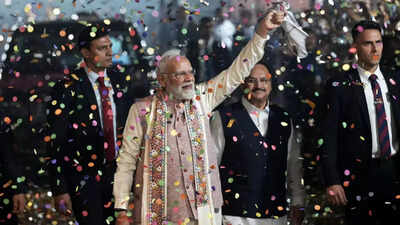NEW DELHI: The Bihar election results on Friday upended every forecast and humbled every pollster as Magadh delivered a sweeping mandate to the Nitish Kumar-led NDA. The verdict was so emphatic that it pushed the opposition Mahagathbandhan to the brink of Bihar’s political canvas, redrawing the state’s electoral landscape in a single stroke.When the results began trickling in the morning, the contest seemed neck-to-neck in the early trends. However, what seemed like the contest soon started fading before turning into a race in the opposite direction, with the National Democratic Alliance (NDA) scaling upward and the Mahagathbandhan dipping downward.The mandate in NDA’s favour was so overwhelming that it effectively redrew Bihar’s political map.
Election Results 2025
Constituencies that glowed green in 2020, when the RJD was the single largest party, were this time engulfed by the NDA’s hue.
NDA did not just win! It delivered a demonstration of how disciplined coalitions, targeted welfare, and carefully stitched caste alliances can overwhelm fragmented opponents in India’s first-past-the-post system.At the centre of this churn stands Nitish Kumar, once again proving his unmatched durability. With the NDA sweeping more than two-thirds of the assembly, Kumar looks set for a tenth term, reinforced by the same formula of clean governance that has defined his political longevity.
In Bihar, ‘Nitishe’ Kumar!
What many dismissed as voter fatigue turned out to be misplaced. Prohibition, policing reforms, and a long arc of women-focused welfare ensured his personal goodwill remained intact. Modi-Nitish, often dismissed as old warhorses, outmanoeuvred the younger pairing of Rahul Gandhi and Tejashwi Yadav with ease.As OBC and EBC voters consolidated behind Nitish Kumar, Prime Minister Modi’s high-octane campaign energised women, youth and swing voters, creating a broad coalition that decisively tilted the mandate in the NDA’s favour. Women voters, in particular, played a decisive role. Higher female turnout in regions like Mithila, Kosi and Magadh translated into clear gains for the NDA. Free ration assurances, Jeevika linkages and the bicycle-to-scooter progression for girls resonated more strongly than the Mahagathbandhan’s job promises. In rural pockets, elderly women openly credited these schemes for their loyalty, strengthening JD(U)’s hold over EBC and Mahadalit segments.The NDA’s cohesive social arithmetic sharply contrasted with the opposition’s fragmentation. The alliance’s vote consolidation reduced the effective number of competing parties to under 2.7, helping convert a moderate vote lead into a towering seat advantage. Chirag Paswan’s mobilisation of Paswan voters and the BJP’s outreach to non-Yadav OBCs and EBCs tightened this consolidation further.
AIMIM dents Mahagathbandhan
Meanwhile, the Mahagathbandhan’s once formidable caste equation cracked. The RJD held on to its Yadav-Muslim nucleus but failed to break into the wider OBC base that powered Nitish’s coalition. Even in Seemanchal, long regarded as an opposition stronghold, the NDA carried several Muslim-majority seats with Muslim candidates, eroding the bloc’s monopoly claim. AIMIM’s 5-6 seats and strong vote shares in others further splintered the minority vote, costing the alliance several close contests.
What went for the opposition?
The Congress emerged as the weakest link. With barely four wins from 61 seats and a dismal strike rate, the party dragged the entire coalition downward. Poor coordination, ineffective candidate selection, and limited campaign visibility reduced it to a burden rather than a partner, raising tough questions about its usefulness in future INDIA bloc formations.Smaller players compounded the opposition’s troubles. Prashant Kishor’s Jan Suraaj secured a respectable 3.5 percent vote share but translated it into zero victories, acting inadvertently as a spoiler in multiple seats. Kishor’s ambitious padyatra created noise but failed to pierce the state’s deeply embedded caste-welfare ecosystem.The Mahagathbandhan’s campaign struggled to present a credible governance alternative. Its messaging leaned heavily on unemployment, voter list controversies and anti-establishment rhetoric while failing to counter the NDA’s development narrative rooted in central schemes and Nitish’s sushasan imprint. Tejashwi Yadav’s rallies drew enthusiasm, particularly from young voters, but the alliance’s lack of narrative coherence and credibility gaps on governance kept it on the defensive.The Bihar verdict is more than an electoral outcome. It is a reminder that political storytelling means little without organisational discipline, credible leadership and a welfare apparatus that reaches the last voter. Nitish Kumar’s NDA succeeded because it understood the state’s social circuitry better than its rivals and turned that understanding into a finely tuned electoral machine. The Mahagathbandhan, weighed down by internal confusion and an eroding caste coalition, simply could not keep pace.For the INDIA bloc, Bihar is not just a setback. It is a flashing red signal. Unless the alliance repairs its credibility deficit, rebuilds grassroots networks and speaks in one coherent voice, it risks becoming electorally irrelevant long before the next electoral test arrives. Go to Source



